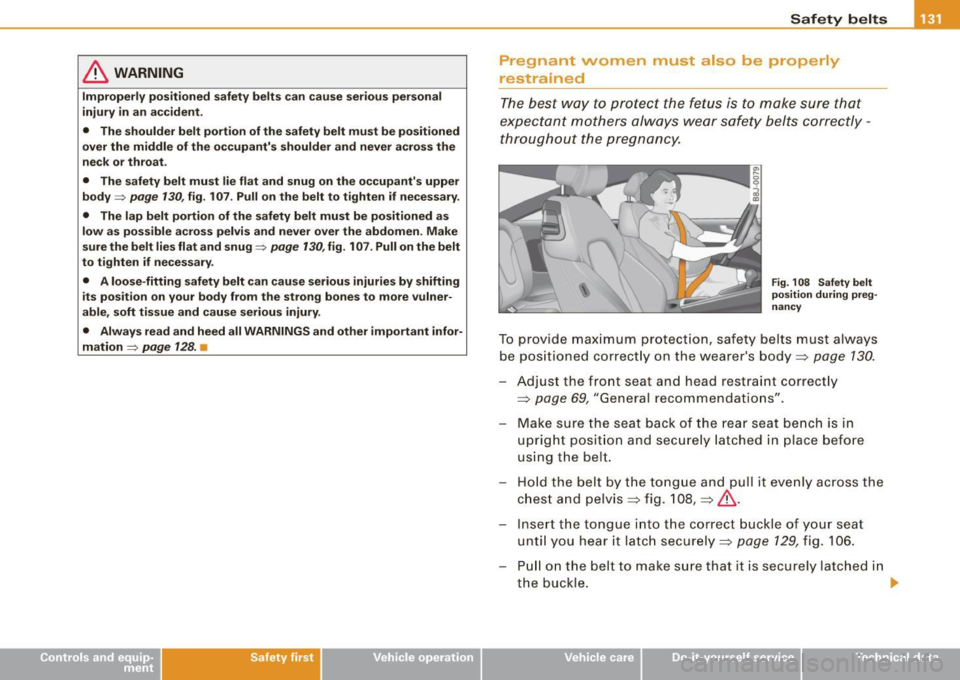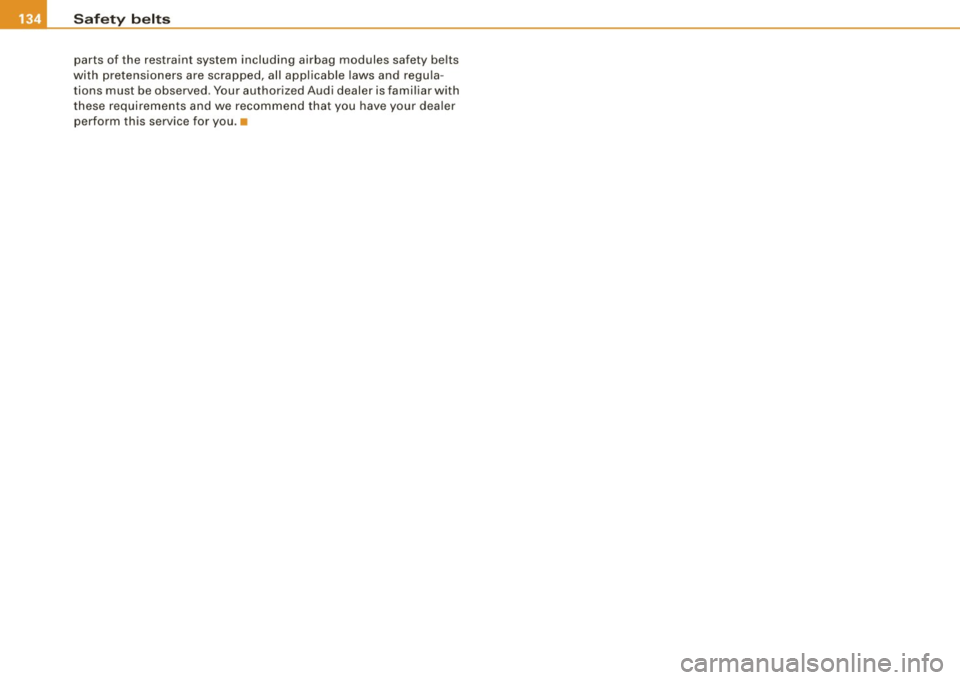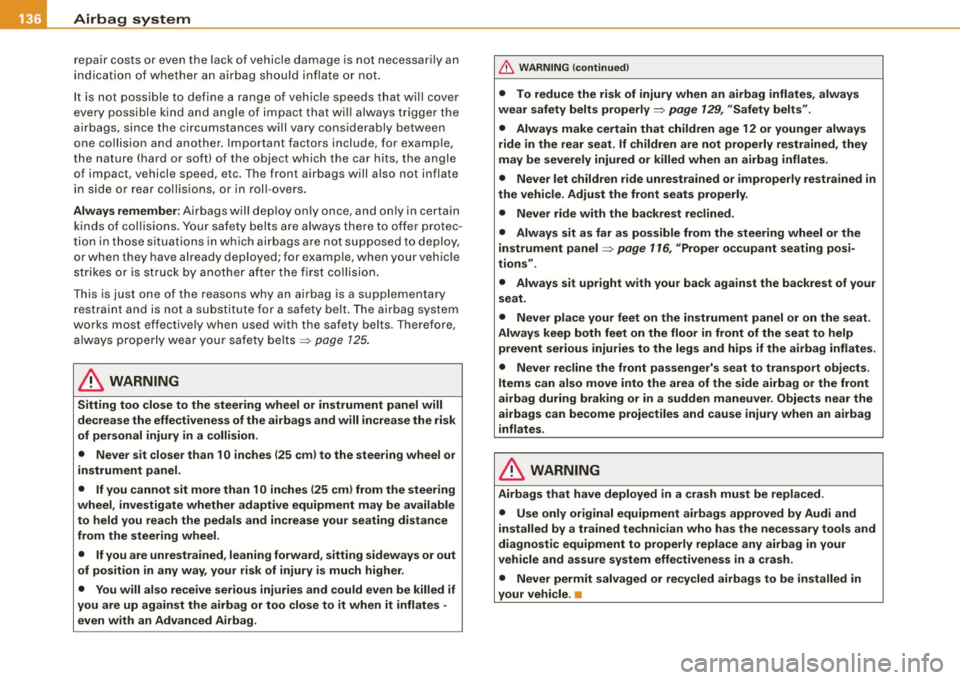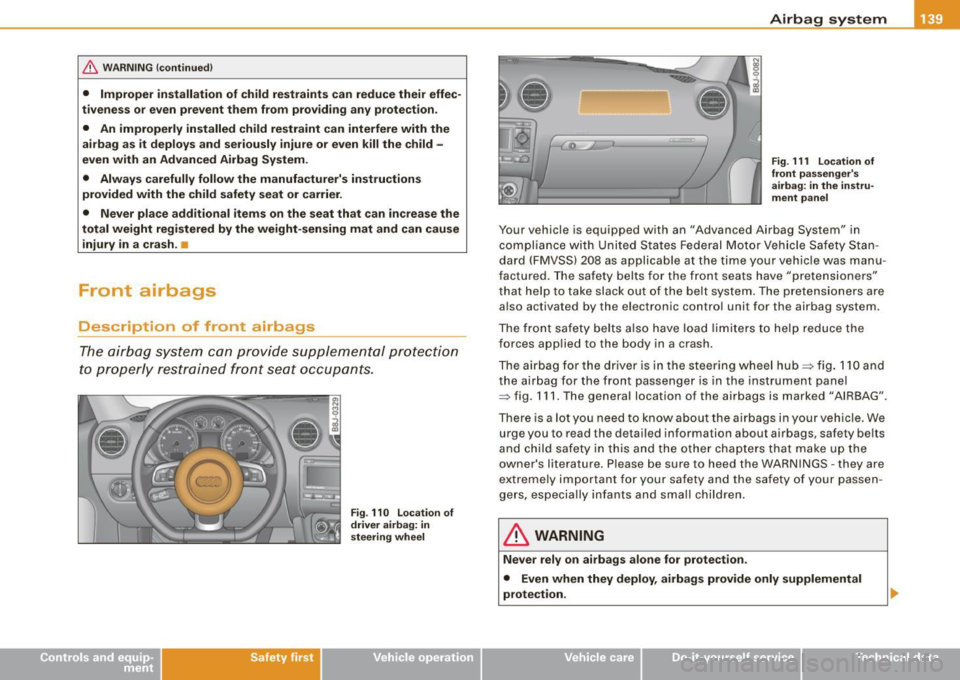2009 AUDI TT COUPE belt
[x] Cancel search: beltPage 133 of 316

& WARNING
Improperly positioned safety belts can cause serious personal
injury in an accident.
• The shoulder belt portion of the safety belt must be positioned
over the middle of the occupant's shoulder and never across the
neck or throat .
• The safety belt must lie flat and snug on the occupant's upper
body =>
page 130, fig. 107 . Pull on the belt to tighten if necessary .
• The lap belt portion of the safety belt must be positioned as
low as possible across pelvis and never over the abdomen. Make
sure the belt lies flat and snug=>
page 130, fig. 107. Pull on the belt
to tighten if necessary.
• A loose -fitting safety belt can cause serious injuries by shifting
its position on your body from the strong bones to more vulner
able, soft tissue and cause serious injury.
• Always read and heed all WARNINGS and other important infor
mation=>
page 128. •
Safety first
Safety belts
Pregnant women must also be properly
restrained
The best way to protect the fetus is to make sure that
expectant mothers always wear safety belts correctly -
throughout the pregnancy.
Fig. 108 Safety belt
position during preg
nancy
To prov ide maximum protection, safety belts must always
be posi tioned correctly on the wearer's body~
page 130.
-Adjust the front seat and head restraint correctly
~ page 69, "General recommendations".
- Make sure the seat back of the rear seat bench is in
upright position and securely latched in place before
using the belt.
- Hold the belt by the tongue and pull it evenly across the
chest and pelvis => fig. 108 ,
~ &.
- Insert the tongue into the correct buckle of your seat
until you hear it latch securely ~
page 129, fig. 106.
- Pull on the belt to make sure that it is securely latched in
the buckle. •
Vehicle care I I irechnical data
Page 134 of 316

-Safety belts ----=-----------------
& WARNING
Improperly positioned
safety belts can cause serious personal
injury in an accident.
• Expectant mothers must always wear the lap portion of the
safety belt as low as possible across the pelvis and below the
rounding of the abdomen.
• Always read and heed all WARNINGS and other important infor
mation =>
& in "Fastening safety belts" on page 129. •
Unfastening safety belts
Unbuckle the safety belt with the red release button only
after the vehicle has stopped.
Fig . 109 Releasing the
tongue from the buckle
-Push the red release button on the buckle=> fig. 109. The
belt tongue will spring out of the buckle=>& .
- Let the belt wind up on the retractor as you guide the belt
tongue to its stowed position.
& WARNING
Never unfasten safety belt while the vehicle is moving. Doing so
will increase your risk of being injured or killed .•
Improperly worn safety belts
Incorrectly positioned safety belts can cause severe inju
ries.
Wearing safety belts improperly can cause serious injury or
death. Safety belts can only work when they are correctly positioned on the body. Improper seating positions reduce
the effectiveness of safety belts and will even increase the
risk of injury and death by moving the safety belt to critical
areas of the body. Improper seating positions also increase
the risk of serious injury and death when an airbag deploys
and strikes an occupant who is not in the correct seating
position . A driver is responsible for the safety of all vehic le
occupants and especially for children. Therefore :
- Never permit anyone to assume an incorrect sitting posi
tion in the vehicle while traveling=>&.
& WARNING
Improperly worn safety belts increase the risk of serious personal
injury and death whenever a vehicle is being used.
• Always make sure that all vehicle occupants are correctly
restrained and stay in a correct seating position whenever the
vehicle is being used.
• Always read and heed all WARNINGS and other important infor
mation
=> page 128. •
Page 135 of 316

Safety b elts -----------------=-----
Safety belt pretensioners
How safety belt pretensioners work
In front and side collisions above a particular severity,
safety belts in use are tensioned automatically.
T he safety belts for the front seating positions are equipped with
safety belt prete nsioners. The system is activated by sensors in
front and side co llisions of great severity. This tightens the belt and
takes up belt slack~
& in "Se rvice and d isposal of safety belt
pretensioner". Taking up the slack he lps to reduce forward occupant
movement during a co llision .
[ i] Tip s
The safety belt p retensione r can on ly be activated once.
• I n minor frontal and side collis ions, in rear -end collisions, in a
rollover and in accidents involving very litt le impact fo rce, the safety
belt pretensioner are not activated.
• When the safety be lt pretensioner is activated, a f ine dust is
released . This is normal and is not caused by a fire in the vehicle.
• The relevant safety require ments must be observed when the
vehicle or components of the system are scrapped. A qualified deal
ership is fami liar with these regulat ions and wil l be p leased to pass
on the information to you.
• Be su re to observe al l safety, env ironmen ta l and othe r regula
tions if the vehicle or individual parts of the system, particu larly the
safety belt or airbag, are to be disposed . We recommend you have
your authorized Audi dealer perform this service for you. •
Controls and equip
ment Safety first Vehicle operation
Service and disposal of safety belt
pretensioner
The safety belt pretensioners a
re parts of the safety belts on your
Audi. Insta lling, removing, servicing or repair ing of belt preten
sioners can damage the safety belt system and prevent it from
work ing correctly in a collision.
There are some important things you have to know to make sure
that the effect iveness of the sys tem will not be impai red and that
discarded components do not cause injury or pol lute the environ
ment .
& WARNING
Improper ca re, servicing and repair procedure s can increa se the
ri sk of personal injury and death b y preventing a safety belt
preten sioner from a ctivating when needed or activating it unex
pe ctedly :
• The belt preten sioner system can be a ctivated only once.
If belt
preten sioner s ha ve been a ctivated , the syste m mu st be repla ced .
• Never repair , adju st, or change any part s of the safety belt
system.
• Safety belt system s including safety belt preten sioners cannot
be repai red . S peci al pro cedures are required for removal , installa
tion and di spo sal of thi s syste m .
• For an y work on the s afety belt system, we strongl y re com
mend that you see your authorized Audi dealer or qualified techni
c ia n who h as an Audi approved repa ir m anual , train ing and spe cia l
equipment nece ssary .
W For the sa ke of the environment
Undeployed airbag modu les and pretensioners might be c lassified
as Perchlorate Material -special handling may apply, see
www .dtsc.ca .gov/hazardouswaste/perchlo rate . When the vehicle or ..,_
Vehicle care Do-it-yourself service Technical data
Page 136 of 316

• ....__S_ a_ fe_ t _y=-- b_ e_ lt_s ________________________________________________ _
parts of the restraint system including airbag modules safety belts
with pretensioners are scrapped, all applicable laws and regu la
tions must be observed . Your authorized Audi dealer is fami liar with
these requirements and we recommend that you have your dea ler
perform this service for you .•
Page 137 of 316

Airbag system -----------------=~-
Airbag system
Important things to know
Importance of wearing safety belts and
sitting properly
Airbags are only supplemental restraints. For airbags to
do their job, occupants must always properly wear their
safety belts and be in a proper seating position.
For your safety and the safety of your passengers, before
driving off, always:
- Adjust the driver's seat and steering wheel properly
~ page 116,
-Adjust the front passenger's seat properly~ page 70,
-Wear safety belts properly~ page 128,
- Always properly use the proper child restraint to protect
children~
page 157.
In a collision airbags must inflate within the blink of an eye and with
considerable force. The supplemental airbags can cause injuries if
the driver or the front seat passenger are not seated properly. There
fore in order to help the airbag to do its job, it is important, both as
a driver and as a passenger to sit properly at all times.
By keeping room between your body and the steering wheel and the
front of the passenger compartment, the airbag can inflate fully and
completely and provide supplemental protection in certain frontal
collisions =>
page 116, "Proper occupant seating positions". For
details on the operation of the seat adjustment controls=>
page 70
and=> page 71.
It's especially important that children are properly restrained
=>
page 157.
Controls and equip ment Safety first Vehicle operation
There is a lot that the driver and the passengers can and must do to
help the individual safety features installed in your Audi work
together as a system.
Proper seating position is important so that the front airbag on the
driver side can do its job. If you have a physical impairment or
condition that prevents you from sitting properly on the driver seat
with the safety belt properly fastened and reaching the pedals, or if
you have concerns with regard to the function or operation of the
Advanced Airbag System, please contact your authorized Audi
dealer or qualified workshop, or call Audi Customer CARE at 1-800-
822 -2834 for possible modifications to your vehicle.
When the airbag system deploys, a gas generator will fill the
airbags, break open the padded covers, and inflate between the
steering wheel and the driver and between the instrument panel
and the front passenger. The airbags will deflate immediately after
deployment so that the front occupants can see through the wind
shield again without interruption.
All of this takes place in the blink of an eye, so fast that many people don't even realize that the airbags have deployed. The airbags also
inflate with a great deal of force and nothing should be in their way
when they deploy. Front airbags in combination with properly worn
safety belts slow down and limit the occupant's forward movement .
Together they help to prevent the driver and front seat passenger
from hitting parts of the inside the vehicle while reducing the forces acting on the occupant during the crash. In this way they help to
reduce the risk of injury to the head and upper body in the crash.
Airbags do not protect the arms or the lower parts of the body.
Both front airbags will not inflate in all frontal collisions. The trig
gering of the airbag system depends on the vehicle deceleration
rate caused by the collision and registered by the electronic control
unit. If this rate is below the reference value programmed into the
control unit, the airbags will not be triggered, even though the car
may be badly damaged as a result of the collision. Vehicle damage,
9J),
Vehicle care Do-it-yourself service Technical data
Page 138 of 316

___ A_ ir_ b_ a-g _ s_y _s_ t_ e_ m _________________________________________________ _
repair costs or even the lack of vehicle dama ge is not necessa rily an
in dic ati on of wh ether a n airb ag s hould infl ate or not.
It is not possib le to define a ran ge of v ehicle spe eds t hat w ill cover
every possible kind and angle of impact that wi ll always trigge r the
a irbags, s ince the circu msta nce s will v ary co nside ra bl y bet ween
one co llision and another. Impo rtant factors include, for e xample,
th e nature (h ard or so ft) o f th e obje ct w hich th e ca r hi ts, the a ng le
of impact, vehicle speed, etc . T he front airbags will also not inflate
i n sid e or r ea r co ll isions, o r in roll-o ve rs.
Always remember : Airba gs will d ep loy only once, and on ly in c ertain
k ind s of co llision s. Yo ur s afe ty bel ts are a lways the re t o offe r protec
ti on i n tho se situat io n s in whic h airba gs a re not suppose d to dep loy,
or when they have a lready dep loye d; f or examp le, when yo ur veh ic le
str ikes o r is s truc k by anot her afte r the fi rst collision .
T his is just one of the reasons why an airbag is a supplementary
r es train t an d is not a su bstit u te fo r a sa fe ty belt. T he ai rbag system
works most eff ectively when used with the safety be lts . T herefore,
a lw ays pro per ly wea r your safe ty be lts ~
page 125.
& WARNING
Sitting too close to the steering wheel or instrument panel will
decrease the effectiveness of the airbags and will increase the risk
of personal injury in a collision.
• Never sit closer than 10 inches (25 cm) to the steering wheel or
instrument panel .
• If you cannot sit more than 10 inches (25 cm ) from the steering
wheel , investigate whether adaptive equipment may be available
to held you reach the pedals and increase your seating distance
from the steering wheel.
• If you are unrestrained , leaning forward, sitting sideways or out
of position in any way, your risk of injury is much higher.
• You will also receive serious injuries and could even be killed if
you are up against the airbag or too close to it when it inflates -
even with an Advanced Airbag .
& WARNING (continued)
• To reduce the risk of injury when an airbag inflates, always
wear safety belts properly=:>
page 129 , "Safety belts".
• Always make certain that children age 12 or younger always
ride in the rear seat. If children are not properly restrained , they
may be severely injured or killed when an airbag inflates.
• Never let children ride unrestrained or improperly restrained in
the vehicle. Adjust the front seats properly .
• Never ride with the backrest reclined.
• Always sit as far as possible from the steering wheel or the
instrument panel=:>
page 116 , "Proper occupant seating posi
tions ".
• Always sit upright with your back against the backrest of your
seat.
• Never place your feet on the instrument panel or on the seat .
Always keep both feet on the floor in front of the seat to help
prevent serious injuries to the legs and hips if the airbag inflates.
• Never recline the front passenger's seat to transport objects .
Items can also move into the area of the side airbag or the front
airbag during braking or in a sudden maneuver. Objects near the
airbags can become projectiles and cause injury when an a irbag
inflates.
& WARNING
Airbags that have deployed in a crash must be replaced .
• Use only original equipment airbags approved by Audi and
installed by a trained technician who has the necessary tools and
diagnostic equipment to properly replace any airbag in your
vehicle and assure system effectiveness in a crash .
• Never permit salvaged or recycled airbags to be installed in
your vehicle . •
Page 141 of 316

& WARNING !continued)
• Improper installation of child restraints can reduce their effec
tiveness or even prevent them from providing any protection .
• An improperly installed child restraint can interfere with the
airbag as it deploys and seriously injure or even kill the child -
even with an Advanced Airbag System.
• Always carefully follow the manufacturer's instructions
provided with the child safety seat or carrier.
• Never place additional items on the seat that can increase the
total weight registered by the weight-sensing mat and can cause injury in a crash. •
Front airbags
Description of front airbags
The airbag system can provide supplemental protection
to properly restrained front seat occupants.
Safety first
Fig . 110 Location of
driver airbag: in
steering wheel
Airbag system
Fig. 111 Location of
front passenger's
airbag: in the instru
ment panel
Your vehicle is equipped with an "Advanced Airbag System" in
compliance with United States Federal Motor Vehicle Safety Stan
dard (FMVSS) 208 as applicable at the time your vehicle was manu
factured. The safety belts for the front seats have "pretensioners"
that help to take slack out of the belt system. The pretensioners are
also activated by the electronic control unit for the airbag system .
The front safety belts also have load limiters to help reduce the
forces applied to the body in a crash.
The airbag for the driver is in the steering wheel hub~ fig.
110 and
the airbag for the front passenger is in the instrument panel
~ fig. 111. The general location of the airbags is marked "AIRBAG".
There is a lot you need to know about the airbags in your vehicle. We
urg e you to read the detailed information about airbags, safety belts
and child safety in this and the other chapters that make up the
owner's literature. Please be sure to heed the WARNINGS -they are
extremely important for your safety and the safety of your passen
gers, especially infants and small children.
& WARNING
Never rely on airbags alone for protection .
• Even when they deploy, airbags provide only supplemental
protection.
Vehicle care I I irechnical data
Page 142 of 316

___ A_ i_r _b _a _ g~ s_ y_ s_t _e _m ___________________________________________________ _
& WARNING (continued)
• Airbag work most effectively when used with properly worn
safety belts .
• Therefore, always wear your safety belts and make sure that
everybody in your vehicle is properly restrained .
& WARNING
A person on the front passenger seat, especially infants and small
children, will receive serious injuries and can even be killed by
being too close to the airbag when it inflates .
• Although the Advanced Airbag System in your vehicle is
designed to turn off the front passenger airbag if an infant or a
small child is on the front passenger seat, nobody can absolutely
guarantee that deployment under these special conditions is
impossible in all conceivable situations that may happen during
the useful life of your vehicle.
• The Advanced Airbag System can deploy in accordance with
the "low risk" option under the U.S. Federal Standard if a child that
is heavier than the typical one-year old child is on the front
passenger seat and the other conditions for airbag deployment
are met.
• Accident statistics have shown that children are generally safer
in the rear seat area than in the front seating position.
• For their own safety, all children, especially 12 years and
younger, should always ride in the back properly restrained for
their age and size . •
Advanced front airbag system
Your vehicle is equipped with a front Advanced Airbag System in
compliance with United States Federal Motor Vehicle Safety Stan
dard 208 as applicable at the time your vehicle was manufactured. The
front Advanced Airbag System supplements the safety belts to
provide additional protection for the driver's and front passenger's
heads and upper bodies in frontal crashes . The airbags inflate only
in frontal impacts when the vehicle deceleration is high enough.
The front Advanced Airbag System for the front seat occupants is
not a substitute for your safety belts . Rather, it is part of the overall
occupant restraint system in your vehicle. Always remember that
the airbag system can only help to protect you, if you are sitting
upright, wearing your safety belt and wearing it properly. This is why
you and your passengers must always be properly restrained, not
just because the law requires you to be.
The Advanced Airbag System in your vehicle has been certified to
meet the "low risk" requirements for 3 and 6 year -old children on the
passenger side and very small adults on the driver side. The low risk
deployment criteria are intended to help reduce the risk of injury
through interaction with the front airbag that can occur, for
example, by being too close to the steering wheel and instrument
panel when the airbag inflates.
In addition, the system has been certified to comply with the
"suppression" requirements of the Safety Standard, to turn off the
front airbag for infants 12 months old and younger who are
restrained on the front passenger seat in child restraints that are
listed in the Standard=>
page 159, "Child restraints and Advanced
Airbags" .
"Suppression" requires the front airbag on the passenger side to be
turned off if:
• a child up to about one year of age is restrained on the front
passenger seat in one of the rear-facing or forward-facing infant
restraints listed in Federal Motor Vehicle Safety Standard 208 with
which the Advanced Airbag System in your vehicle was certified. For
a listing of the child restraints that were used to certify your
vehicle's compliance with the US Safety Standard=>
page 159,
• weight less than a threshold level stored in the control unit is
detected on the front passenger seat. .,